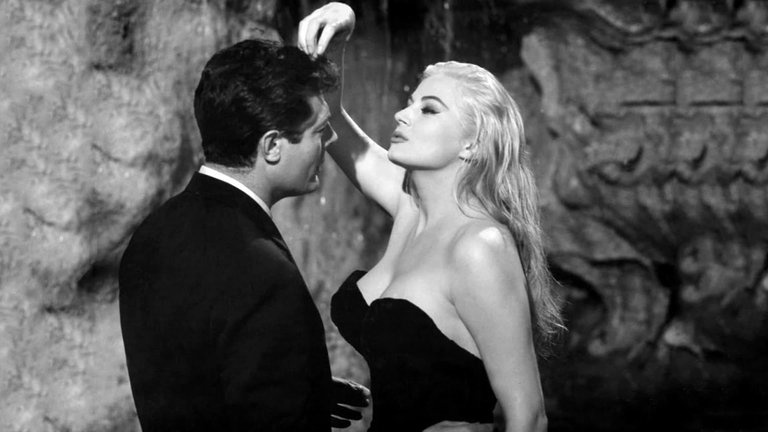Film Review: La dolce vita (The Sweet Life, 1960)

When a foreign film retains its original title in the United States and other countries, it often signifies that the film is not only of exceptional quality but also holds considerable cultural significance. This phenomenon is particularly evident with La dolce vita, the 1960 Italian drama directed by Federico Fellini. The film's title has entered global vocabularies, symbolizing a lifestyle of indulgence and excess, and it is frequently cited as one of the greatest films ever made. Celebrated as perhaps the pinnacle of Fellini's oeuvre, La dolce vita stands as an iconic achievement in Italian cinema, encapsulating themes of existential ennui against a backdrop of post-war affluence.
Set in contemporary Rome, La dolce vita opens with a striking scene where a helicopter transports a statue of Jesus to the Vatican. This surreal spectacle is chronicled by the protagonist, Marcello Rubini, played by Marcello Mastroianni. Marcello's life is one of relative comfort, shared with his emotionally volatile fiancée, Emma (played by Yvonne Fourneaux), whose jealousy is not unfounded given Marcello's lifestyle. As a celebrity journalist, he spends his nights in Rome's most exclusive bars and nightclubs, accompanied by the intrusive photographer Paparazzo (played by Walter Santesoo). Their escapades allow Marcello to mingle with the city's elite and international jet set while indulging in a playboy lifestyle. Women like the nymphomaniac aristocrat Maddalena (played by Anouk Aimée) throw themselves at him, while others, such as the voluptuous Swedish film star Sylvia (played by Anita Ekberg), seem tantalisingly out of reach. Despite this façade of a "sweet life," Marcello grapples with an inner emptiness and harbours dreams of becoming a serious writer, idolising his friend Steiner (played by Alain Cuny), an intellectual figure who embodies the depth he craves.
The film’s iconic status can be largely attributed to Otello Martelli's black-and-white cinematography, which immortalises memorable images that have become part of collective memory—most notably Sylvia’s enchanting entrance into the Trevi Fountain and the helicopter carrying the statue of Christ. The opening scene serves not only as an introduction to Rome but also as a poignant contrast between its pagan past and Christian present. The statue represents tradition, while the helicopter signifies modernity; this juxtaposition is further highlighted when bikini-clad women sunbathing on a rooftop catch Marcello’s attention as he attempts to obtain their phone numbers from above. This moment encapsulates the tension between traditional Christian morality and contemporary permissiveness.
Following this striking introduction, La dolce vita unfolds through a series of loosely connected vignettes or chapters that predominantly take place at night, painting a vivid portrait of Marcello's world. This episodic structure allows for rich observations about appearances versus reality; for instance, newly constructed housing blocks stand amidst mud and failing infrastructure. In stark contrast to the Italian neorealism that characterised Fellini's earlier works—a style referenced within the film—La dolce vita explores the seemingly fairytale existence of the wealthy and famous, where emotional emptiness and ennui dominate their lives. Fellini’s use of widescreen format enhances both the epic quality of the narrative and the opulence of Rome's elite lifestyle, seducing audiences just as it does Marcello.
However, this vignette-like structure also presents challenges; some episodes lack impact compared to others. Despite this inconsistency, the overall quality remains high due to Fellini’s masterful direction and an outstanding cast. Arguably the best episode features Marcello’s estranged father (played by Annibale Ninci), a travelling salesman who experiences a brief seduction by his son’s glamorous lifestyle during his visit.
The episodic nature of La dolce vita contributes to its lack of clear focus; at nearly three hours long, it risks testing the patience of contemporary audiences unaccustomed to such pacing. In contrast, audiences in 1960 embraced it wholeheartedly; it was immediately recognised as a masterpiece, winning the prestigious Palme d'Or at Cannes and achieving significant box office success across Europe. This acclaim solidified Fellini's reputation as one of cinema's most influential figures.
Much of this success can be attributed to the controversy surrounding La dolce vita, particularly from the Catholic Church due to its perceived "amoral" content. Fellini incorporated risqué elements into his narrative—such as Marcello and Maddalena using a prostitute's apartment and an orgy scene featuring openly homosexual characters—which likely appeared quite explicit for early 1960s audiences. Yet today’s viewers may find these scenes relatively tame; even Nadia Gray’s impressive striptease seems less provocative in a contemporary context. The Church was particularly incensed by scenes involving alleged Marian apparitions that culminate in tragedy. Ironically, such backlash only served to amplify publicity for Fellini’s film.
For modern audiences, La dolce vita provides fascinating insights into societal dynamics from six decades ago while subtly hinting at impending changes during a turbulent decade ahead. The film's soundtrack by Nino Rota may not be among his most memorable works but skillfully incorporates elements of jazz alongside emerging rock 'n' roll influences—most notably represented by Adriano Celentano's cameo appearance.
Fellini appears intrigued by this future through the character Paola (played by Valeria Ciangottini), a waitress at a beachside bar who embodies angelic beauty and innocence. Marcello becomes captivated by her purity and reconnects with her during the film’s symbolic epilogue on the beach. The film concludes with Paola's face filling the frame—a nod to François Truffaut's similar ending in The 400 Blows, which had been released just a year earlier.
Despite its imperfections—such as its sprawling narrative structure—La dolce vita has secured its place in cinematic history and continues to rank highly on critics’ lists of all-time great films. Its legacy endures through phrases like "la dolce vita," which have entered common parlance, while characters like Paparazzo inspired new word for photographers who chase celebrities.
RATING: 8/10 (+++)
Blog in Croatian https://draxblog.com
Blog in English https://draxreview.wordpress.com/
InLeo blog https://inleo.io/@drax.leo
Hiveonboard: https://hiveonboard.com?ref=drax
Rising Star game: https://www.risingstargame.com?referrer=drax
1Inch: https://1inch.exchange/#/r/0x83823d8CCB74F828148258BB4457642124b1328e
BTC donations: 1EWxiMiP6iiG9rger3NuUSd6HByaxQWafG
ETH donations: 0xB305F144323b99e6f8b1d66f5D7DE78B498C32A7
BCH donations: qpvxw0jax79lhmvlgcldkzpqanf03r9cjv8y6gtmk9